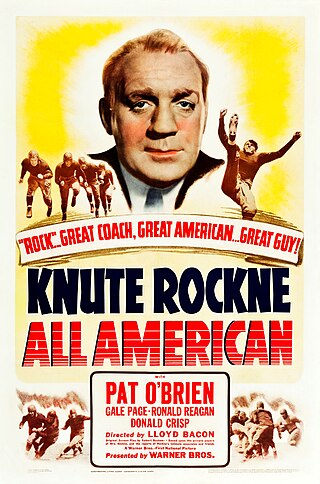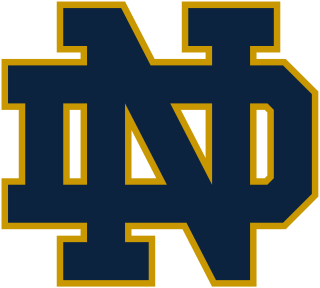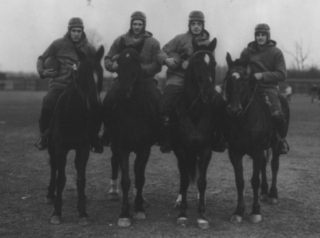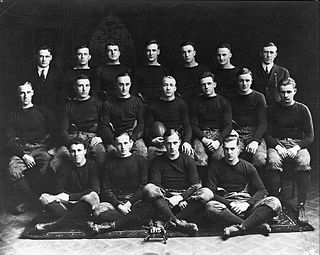Related Research Articles

Knute Kenneth Rockne was an American football player and coach at the University of Notre Dame. Leading Notre Dame for 13 seasons, Rockne accumulated over 100 wins and three national championships.

Knute Rockne, All American is a 1940 American biographical film that tells the story of Knute Rockne, Notre Dame's legendary football coach. It stars Pat O'Brien as Rockne and Ronald Reagan as player George Gipp, as well as Gale Page, Donald Crisp, Albert Bassermann, Owen Davis Jr., Nick Lukats, Kane Richmond, William Marshall and William Byrne. The film also includes cameos by legendary football coaches "Pop" Warner, Amos Alonzo Stagg, William H. Spaulding and Howard Jones, playing themselves.

George Gipp, nicknamed "The Gipper", was a college football player at the University of Notre Dame under head coach Knute Rockne. Gipp was selected as Notre Dame's first Walter Camp All-American, and played several positions, particularly halfback, quarterback, and punter.

Francis William Leahy was an American football player, coach, college athletics administrator, and professional sports executive. He served as the head football coach at Boston College from 1939 to 1940 and at the University of Notre Dame from 1941 to 1943 and again from 1946 to 1953, compiling a career college football record of 107–13–9. His winning percentage of .864 is the second best in NCAA Division I football history, trailing only that of fellow Notre Dame Fighting Irish coach Knute Rockne, for whom Leahy played from 1928 to 1930. Leahy played on two Notre Dame teams that won national championships, in 1929 and 1930, and coached four more, in 1943, 1946, 1947, 1949. Leahy was also the athletic director at Notre Dame from 1947 until 1949 when he passed the role to the Fighting Irish basketball coach Moose Krause so that he could focus on football coaching. Leahy served as the general manager for the Los Angeles Chargers of the American Football League (AFL) during their inaugural season in 1960. He was inducted into the College Football Hall of Fame as a coach in 1970.

The Notre Dame Fighting Irish football team is the intercollegiate football team representing the University of Notre Dame in Notre Dame, Indiana, north of the city of South Bend, Indiana. The team plays its home games at the campus' Notre Dame Stadium, which has a capacity of 77,622. Notre Dame is one of seven schools that competes as an Independent at the National Collegiate Athletic Association (NCAA) Football Bowl Subdivision (FBS) level; however, they play five games a year against opponents from the Atlantic Coast Conference (ACC), of which Notre Dame is a member in all other sports except ice hockey.

Notre Dame Stadium is an outdoor football stadium in Notre Dame, Indiana, the home field of the University of Notre Dame Fighting Irish football team.

The Four Horsemen of Notre Dame comprised a group of American football players at the University of Notre Dame under coach Knute Rockne. They were the backfield of Notre Dame's 1924 football team. The players that made up this group were Harry Stuhldreher, Don Miller, Jim Crowley, and Elmer Layden.
Notre Dame Fighting Irish football rivalries refers to rivalries of the University of Notre Dame in the sport of college football. Because the Notre Dame Fighting Irish are independent of a football conference, they play a national schedule, which annually includes historic rivals University of Southern California and Navy, more recent rival Stanford, and five games with ACC teams.
John Edward Chevigny was an American football player, coach, lawyer, and United States Marine Corps officer who was killed in action on the first day of the Battle of Iwo Jima in World War II. He is best known for scoring the famous "that's one for Gipper" touchdown for Notre Dame on November 10, 1928, versus Army at Yankee Stadium. One of the Great Depression-era football stars, he was one of the best blocking backs for Knute Rockne's Notre Dame football team in the 1920s. Chevigny later served as the head coach of the Chicago Cardinals of the National Football League in 1932 and the head football coach at the University of Texas from 1934 to 1936.

The 1946 Army vs. Notre Dame football game was a regular season college football game played on November 9, 1946. Army, then ranked No. 1 in the Associated Press college football poll, played the University of Notre Dame, of South Bend, Indiana, ranked No. 2, at Yankee Stadium in The Bronx.

The Band of the Fighting Irish is the marching band of the University of Notre Dame. Over 300 members of the band represent nearly every field of study, and include students from across the United States as well as from overseas. The Band of the Fighting Irish is composed of students from the University of Notre Dame, Saint Mary's College, and Holy Cross College. Founded in 1845, it is the oldest university marching band.
The 1925 Rose Bowl was a college football bowl game. It was the 11th Rose Bowl Game. The Notre Dame Fighting Irish defeated Stanford University, 27–10. The game featured two legendary coaches, Knute Rockne of Notre Dame, and Pop Warner in his first year at Stanford. The game also featured the Four Horsemen of Notre Dame. Elmer Layden of Notre Dame and Ernie Nevers of Stanford were named the Rose Bowl Players Of The Game when the award was created in 1953 and selections were made retroactively.

The 1924 college football season was the year of the Four Horsemen as the Notre Dame team, coached by Knute Rockne, won all of its games, including the Rose Bowl, to be acclaimed as the best team in the nation. Notre Dame and Stanford were both unbeaten at season's end, with the Fighting Irish winning the Rose Bowl contest 27–10. The Penn Quakers were retroactively awarded a national championship by Parke H. Davis.

The Notre Dame–USC football rivalry is an American college football rivalry between the Notre Dame Fighting Irish football team of the University of Notre Dame and USC Trojans football team of the University of Southern California, customarily played on the Saturday following Thanksgiving Day when the game is in Los Angeles or on the second or third Saturday of October when the game is in South Bend, Indiana.

The 1913 Notre Dame Fighting Irish football team represented the University of Notre Dame during the 1913 college football season.

The 1919 Notre Dame Fighting Irish football team was an American football team that represented the University of Notre Dame as an independent during the 1919 college football season. The team compiled a perfect 9–0 record and outscored opponents by a total of 229 to 47.

The 1924 Notre Dame Fighting Irish football team was an American football team that represented the University of Notre Dame as an independent during the 1924 college football season. In their seventh season under head coach Knute Rockne, the Fighting Irish compiled a perfect 10–0 record, defeated Stanford in the 1925 Rose Bowl, and outscored opponents by a total of 285 to 54. The team was led by the legendary backfield known as the "Four Horsemen" consisting of quarterback Harry Stuhldreher, halfbacks Don Miller and Jim Crowley, and fullback Elmer Layden.

The 1918 Notre Dame Fighting Irish football team represented the University of Notre Dame during the 1918 college football season.
The 1931 Notre Dame Fighting Irish football team represented the University of Notre Dame during the 1931 college football season, led by first-year head coach Hunk Anderson.
References
- ↑ Cavanaugh, Jack (2010). The Gipper: George Gipp, Knute Rockne, and the Dramatic Rise of Notre Dame Football. New York: Skyhorse Publishing
- ↑ "Why NYC cheers Notre Dame's Fighting Irish". New York Post. 2013-12-27. Retrieved 2018-07-10.
- ↑ "Archives - Philly.com". articles.philly.com. Retrieved 2018-07-10.
- ↑ Boyd, Andrew. "History". Notre Dame Club of Italy. Retrieved 26 September 2016.
- ↑ Pennington, Bill. "Army-Notre Dame Game Stirs Yankee Stadium's Football Ghosts" . Retrieved 2018-07-10.
- ↑ "Army against Notre Dame, once the big football game of - 10.14.57 - SI Vault". sportsillustrated.cnn.com. Archived from the original on 2014-02-22.
- ↑ Dame, Marketing Communications: Web // University of Notre. "Home". mynotredame.nd.edu. Retrieved 2018-07-10.
- ↑ Dame, Marketing Communications: Web // University of Notre. "ND Clubs Not Just For Alums". mynotredame.nd.edu. Retrieved 2018-07-10.
- ↑ "Celebrity Notre Dame and Alabama College Football Fans (PHOTOS)". The Daily Beast. 2013-01-07. Retrieved 2018-07-10.
- ↑ "Catching Up With Vince Vaughn" . Retrieved 2018-07-10.
- ↑ Elmer, Emily O'Neill. "Notre Dame Football: Top 5 Celebirty Fighting Irish Fans". Bleacher Report. Retrieved 2018-07-10.
- ↑ "Notre Dame Fighting Irish". ESPN.com. Retrieved 2018-07-10.